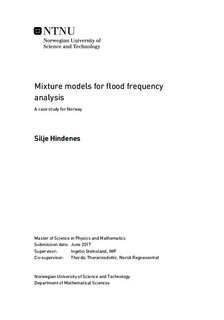Mixture models for flood frequency analysis - A case study for Norway
Master thesis
Permanent lenke
http://hdl.handle.net/11250/2458159Utgivelsesdato
2017Metadata
Vis full innførselSamlinger
Sammendrag
Flood frequency analysis (FFA) concerns prediction of the magnitude and corresponding frequency of extreme flood events. Extreme floods can be the result of various hydrological processes. In Norway, rainfall and snowmelt are considered to be the two main flood generating processes. The use of mixture models, to account for these different flood generating processes, are investigated for catchments in Norway. For the case of annual maximum series (AMS), a two-component mixture of Gumbel distributions is fitted, by assuming that the mixture weights are both known and unknown. Subsequently, for peaks over threshold (POT) series a two-component mixture of exponential distributions is considered. Again, the two cases of known and unknown mixture weights are studied. When assuming that the mixture weights are known, these are given by the precalculated proportion of rainfall and snowmelt contributing to each flood value. The mixture models are compared to the generalized extreme value (GEV) distribution and the Gumbel distribution for AMS, and to the generalized Pareto (GP) distribution and the exponential distribution for POT. Maximum likehood is used for parameter estimation, and for the mixture models with unknown weights the maximum likehood estimates are obtained by the expectation maximization (EM) algorithm. The predictive performance of the models are compared using various scoring rules. In addition, the stability of the models are compared. We found that although the scoring rules are not always able to differentiate between the models, the Gumbel distribution and the exponential distribution, for the case of AMS and POT respectively, often give the most reliable and stable estimates. The mixture models estimated by the EM algorithm occasionally give unexpected results and seems unfit for practical use in FFA.
